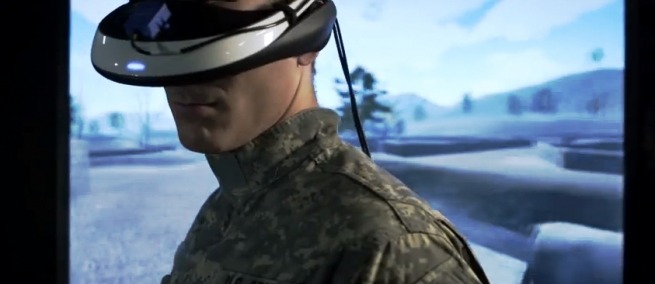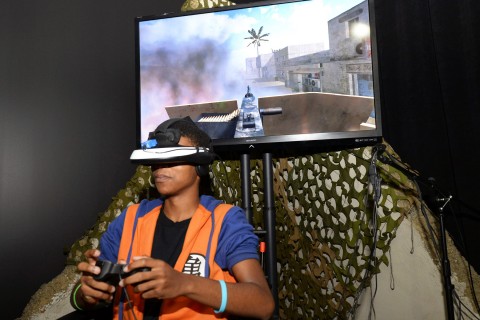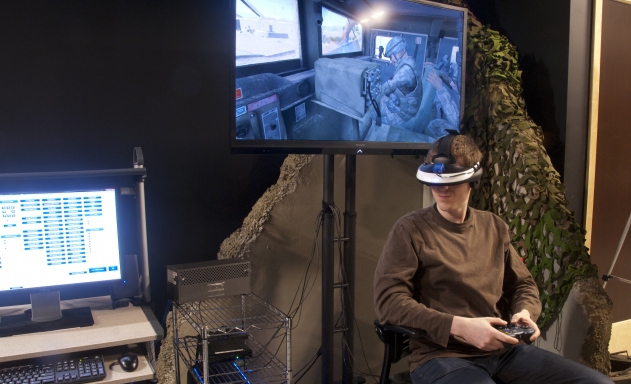
[Editor’s Note: Science & Film asked Mount Sinai neuroscientist Dr. Heather Berlin to write about the symptoms of Post Traumatic Stress Disorder and the way moving image technology is currently being used by clinicians. A number of narrative and documentary films feature characters who struggle with the disorder. In the 2017 film Rebel in the Rye, J.D. Salinger suffers after returning from World War II. The 2014 documentary Of Men And War is set in a treatment center for veterans.]
Recently I treated a patient who presented with symptoms of anxiety and depression, and had an excessive preoccupation with a perceived flaw in his appearance, accompanied by repetitive avoidance behaviors known as “body dysmorphic disorder” (BDD). His BDD manifested as a belief that people were judging him for a skin condition (mild eczema), which in fact was barely noticeable. As a result, he was unable to go out in public without severe anxiety, which often led to panic attacks. His subsequent agoraphobia (fear of public open spaces) and reluctance to leave his home was particularly inconvenient for his job as a police sergeant. But, after several sessions of delving into his personal history, symptoms, and recent experiences, I discovered that my patient was also suffering from Post Traumatic Stress Disorder (PTSD).
PTSD is a pathologic response to an experienced or witnessed traumatic event (or series of events) that elicits horror, intense fear, or helplessness. Symptoms of PTSD include re-experiencing the traumatic event via intrusive and persistent memories, recurrent nightmares and flashbacks, avoidance of thoughts, feelings, activities, and stimuli associated with the traumatic event, amnesia, reduced ability to feel emotions (numbing), hyperarousal including difficulty sleeping and concentrating, and being easily startled, as well as anger and irritability [1]. Like many police officers, my patient had seen some horrible things and experienced life-threatening situations regularly on the job, which over time culminated in an array of these symptoms.
The most publicized cases of PTSD are in military veterans, but the disorder can affect anyone who has been exposed to a traumatic event or series of events, domestic or job-related. Severe trauma is encountered in some form by approximately one third of the population [2], and around 15% to 24% of those exposed will develop PTSD [3,4]. Studies report that PTSD is more prevalent in women, with some citing a 2:1 female-to-male ratio of lifetime prevalence [3,4]. There is also evidence of a heritable component to PTSD, and a history of depression in first-degree relatives is associated with increased likelihood of its onset. The lifetime prevalence for PTSD in the general adult population in the US is approximately 8.7% [1,5], while a study from Badge of Life, a non-profit organization that investigates trauma in police, estimates the number of police officers with PTSD at about 20%. To highlight this, a recent article connecting the effects of PTSD with the current national discussion around police brutality and Black Lives Matter referred to PTSD in police as an “undiagnosed epidemic”. Approximately 50% of patients completely recover form PTSD within 3 months [1]; but, in about one third of patients, symptoms can remain for more than ten years after the trauma [6].

One of the most effective treatments for PTSD is prolonged exposure therapy, which involves having the patient encounter anxiety-provoking stimuli in a safe context through small, controlled exposures (real or imagined). The goal is for the patient to eventually habituate and desensitize to the fear inducing-stimuli (including memories) and decrease the severity of their emotional responses to them. Exposure therapy is a well-studied and experimentally validated treatment for PTSD, and one of its most exciting new developments employs virtual reality (VR) technology to aid in exposures. Virtual reality exposure therapy has been shown to be effective in a range of anxiety disorders including arachnophobia (fear of spiders), acrophobia (fear of heights), social anxiety, and aerophobia (fear of flying). But its application to PTSD is perhaps the most well documented, with significant positive results.
VR headsets allow for a highly curated exposure experience, in a setting that patients rationally know is perfectly safe, while giving clinicians the ability to tailor stimuli directly to the details of the patient’s traumatic experience. As seen in the below video from the Institute for Creative Technologies lab at the University of Southern California, VR headsets put you in a fully-immersive environment where you can see and hear (and in some cases smell and touch) the details of a place. You can explore every aspect of the virtual world at your own pace, like a video game that you control. It is not always practical, or in some cases safe, to have people with arachnophobia touch a real spider, or to put someone with PTSD back in a life-threatening situation. But a clinician can use VR to recreate, for example, a battlefield scene for a military veteran, maximizing perceptual realism while minimizing the real danger associated with being on the frontline.
VR can also give us insights into the way the brain processes information and identifies threats in the external environment. My colleague Anil Seth at the University of Sussex has designed virtually reality immersions that artificially distort the user’s body parts, making their limbs change color and appear very large or very small. This targets the neural circuits that are malfunctioning in people with body dysmorphic disorder who have a distorted perception of their own particular body part. Seth also has an augmented reality (AR) program that causes users to perceive dogs everywhere in a familiar environment. Each shape that could possibly be perceived as part of a dog is converted by the visual software into a fully detailed canine, giving the user a first-hand experience of “DogWorld”, in which dogs are literally lurking behind every corner and on every visible surface around you. Of course, the dogs aren’t really there, and neither are the threats that underlie many anxiety, trauma, and stressor-related disorders, including PTSD. But by showing people first hand what it feels like to have their cognition malfunction in a certain harmless way (e.g. by seeing dogs that are not really there), it is possible for them to understand by analogy what is happening in their mind to provoke their anxieties; they are overgeneralizing and falsely perceiving otherwise benign stimuli in their environment as threatening. In many cases, insight into a patient’s own disorder is the first step to recovery.

My patient initially presented with severe anxiety, and from his description of the traumatic situations he was encountering regularly at work, and his symptoms, I was able to make a diagnosis of PTSD and begin the appropriate treatment. He is fortunately back at work now and functioning well in all aspects of his life. I treated him with good old-fashioned imaginal and in vivo exposure therapy, but I look forward to experimenting with VR exposure therapy in both my clinical work and research. As the cost comes down and the evidence base increases, it’s heartening to know that an innovative new technology designed initially for entertainment also has the potential to alleviate mental suffering in those who need it most.
References:
1. American Psychiatric Association. Diagnostic and statistical manual of mental disorders (5th ed.), 2013. Washington, DC: Author.
2. Breslau N, Kessler RC, Chilcoat HC, et al.: Trauma and posttraumatic stress disorder in the community. Arch Gen Psychiatry 1998, 55:626–632.
3. Breslau N: Outcomes of posttraumatic stress disorder. J Clin Psychiatry 2001, 62(Suppl 17):55–59.
4. Kessler RC, Sonnega A, Bromet E, et al.: Posttraumatic stress disorder in the National Comorbidity Survey. Arch Gen Psychiatry 1995, 52:1048–1060.
5. Kessler, R.C., Berglund, P., Delmer, O., Jin, R., Merikangas, K.R., & Walters, E.E. Lifetime prevalence and age-of-onset distributions of DSM-IV disorders in the National Comorbidity Survey Replication. Archives of General Psychiatry 2005, 62(6): 593-602.
6. Iancu I, Rosen Y, Moshe K: Antiepileptic drugs in posttraumatic stress disorder. Clin Neuropharmacol 2002, 25:225–229.